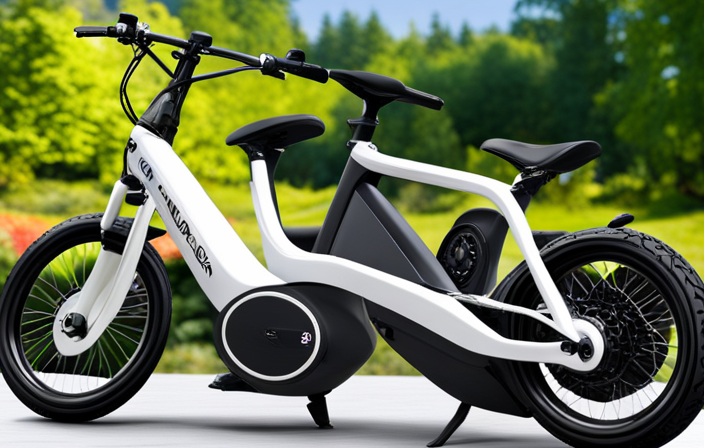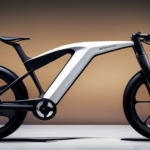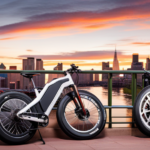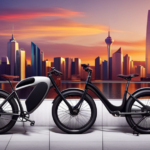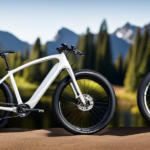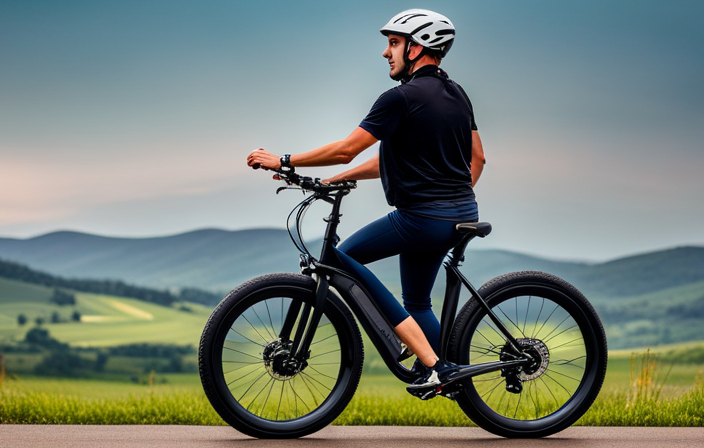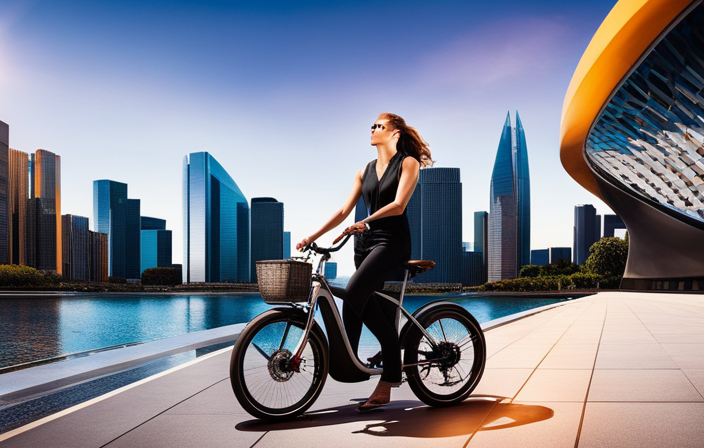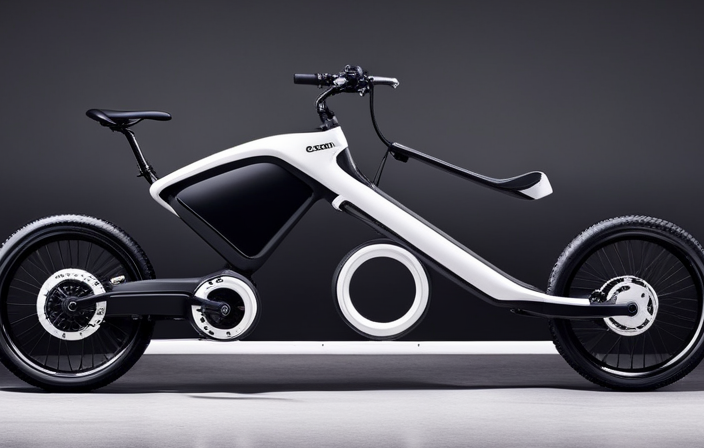Ever pondered what makes electric bicycles carry such a substantial cost?
Well, it’s like the old saying goes: ‘You get what you pay for.’
In this article, we will delve into the reasons behind the seemingly high cost of electric bikes.
From advanced technology and high-quality components to research and development expenses, we will explore the factors that contribute to their price.
So, fasten your seatbelts as we take a closer look at why electric bikes are so expensive.
Key Takeaways
- Advanced technology and features, high-quality components, premium frame materials, and top-of-the-line drivetrain and gears contribute to the high cost of electric bikes.
- Research and development costs, production limitations and scale, and customization and personalization options also contribute to the high price of electric bikes.
- The environmental impact and long-term cost savings of electric bikes are significant factors to consider when evaluating their high cost.
- Brand reputation and quality assurance, regulatory compliance and safety standards, cost of raw materials, and supply chain disruptions and fluctuations all affect the cost of electric bikes.
Advanced Technology and Features
Electric bikes are expensive because they have advanced technology and features. One major factor contributing to the high cost is the advanced battery technology used in electric bikes. These bikes require powerful and long-lasting batteries to provide sufficient power for longer rides. The development and manufacturing of such batteries involve extensive research and high production costs.
Additionally, electric bikes are equipped with innovative motor systems that provide efficient and smooth performance. These motors are designed to deliver high torque and power, making the biking experience enjoyable and effortless. The integration of these advanced technologies adds to the overall cost of electric bikes.
Furthermore, the high-quality components used in electric bikes, such as durable frames, reliable brakes, and premium tires, also contribute to their expensive price tag. These components ensure a safe and comfortable ride, but they come at a higher cost.
Therefore, the combination of advanced technology and high-quality components makes electric bikes more expensive than traditional bicycles.
High-Quality Components
When it comes to high-quality components, there are a few key points to consider.
Firstly, premium frame materials such as carbon fiber or titanium are often used in expensive electric bikes. These materials are lightweight, strong, and durable, providing a smooth and comfortable ride.
Secondly, a top-of-the-line drivetrain and gears are essential for optimal performance and efficiency. These components ensure smooth shifting, precise control, and maximum power transfer.
Lastly, durable and reliable tires and wheels are crucial for a safe and enjoyable riding experience. High-quality tires and wheels provide excellent grip, stability, and puncture resistance, allowing riders to confidently navigate various terrains.
Premium frame materials
Although the premium frame materials used contribute to the high cost of electric bikes, their durability and lightweight properties make them a worthwhile investment.
Electric bikes often incorporate alternative materials like carbon fiber or titanium, which are known for their strength and low weight. These materials undergo a meticulous manufacturing process to ensure maximum performance and longevity.
Carbon fiber frames, for example, are made by layering carbon sheets and epoxy resin and then molding them into shape. This results in a frame that is not only incredibly strong but also exceptionally lightweight.
Titanium frames, on the other hand, offer a unique combination of strength and flexibility. The intricate design and high-quality construction of these frames require skilled craftsmanship and advanced techniques.
With such premium frame materials, electric bikes are able to provide a superior riding experience.
Moving on to the next section about top-of-the-line drivetrain and gears, electric bikes offer even more impressive features.
Top-of-the-line drivetrain and gears
The drivetrain and gears of premium electric bikes are designed with top-of-the-line components for optimal performance. These high-quality drivetrains and gears are crucial for ensuring smooth and efficient power transfer from the motor to the wheels.
One key factor in drivetrain efficiency is the gear ratio optimization. By carefully selecting the gear ratios, manufacturers can maximize the power output while minimizing energy loss. This results in a more efficient and responsive ride, allowing riders to conquer steep hills and accelerate quickly with ease.
Additionally, the top-of-the-line drivetrain components are built to withstand the demands of electric bike riding, providing durability and longevity. These drivetrains and gears are specifically engineered to handle the increased torque and power output of electric motors. As a result, riders can enjoy a seamless and reliable riding experience.
Moving on to the next section about durable and reliable tires and wheels, it is important to consider the impact these components have on the overall performance of an electric bike.
Durable and reliable tires and wheels
To ensure a smooth and reliable ride, you’ll appreciate the durability and reliability of the tires and wheels on these premium electric bikes. These high-end electric bikes are equipped with tires and wheels that are specifically designed for long-lasting performance and puncture resistance. Here are four key features that contribute to their exceptional quality:
-
Reinforced sidewalls: The tires are constructed with reinforced sidewalls that provide extra strength and protection against punctures, ensuring a worry-free ride even on rough terrains.
-
High-quality rubber compounds: The tires are made from top-grade rubber compounds that offer excellent grip and traction, enhancing the overall stability and control of the bike.
-
Double-walled rims: The wheels are built with double-walled rims, which not only add strength and durability but also provide better impact resistance.
-
Precision-spoked wheels: The wheels are meticulously spoked, ensuring maximum strength and stability, even during high-speed rides.
These premium features contribute to the higher cost of electric bikes, as they require advanced materials and manufacturing techniques.
Transitioning into the subsequent section about research and development costs, it becomes evident that creating such high-performance electric bikes involves extensive investment and innovation.
Research and Development Costs
Electric bike prices are higher due to the significant costs of research and development. Research funding is essential for the innovation and technological advancements that make electric bikes more efficient, powerful, and reliable. These advancements require extensive testing and experimentation, which can be expensive. Additionally, the development of new features and technologies, such as advanced battery systems and motor controllers, adds to the overall cost of electric bikes. To illustrate the impact of research and development costs, consider the table below:
| Research and Development Costs |
|---|
| Testing and Experimentation |
| New Feature Development |
| Technological Advancements |
| Innovation and Design |
| Total Research Costs |
As you can see, the costs associated with research and development significantly contribute to the higher prices of electric bikes. Moving forward, we will explore another factor that affects the cost of electric bikes: production limitations and scale.
Production Limitations and Scale
As I mentioned before, research and development costs play a significant role in the high price of electric bikes. However, production limitations and scale also contribute to their expense.
When it comes to manufacturing electric bikes, there are challenges in achieving high production efficiency due to the complex nature of the technology involved. Additionally, the demand for electric bikes is still growing, which means that manufacturers may not have reached the optimal scale to achieve economies of scale.
To delve deeper into this issue, let’s explore three factors that affect production limitations and scale:
- Component Sourcing: Obtaining high-quality components for electric bikes can be a lengthy and costly process.
- Assembly Complexity: Assembling electric bikes requires specialized knowledge and skills, which can slow down production.
- Factory Capacity: Limited factory capacity can restrict the number of electric bikes that can be produced within a given time frame.
Considering these factors, it becomes evident that production limitations and scale contribute to the higher price of electric bikes. However, there is another aspect that also impacts their cost: customization and personalization options.
Customization and Personalization Options
If you want a personalized electric bike, there are various customization options available to suit your specific preferences and needs. Many electric bike manufacturers understand the importance of offering personalization choices to their customers.
From choosing the color and design of the frame to selecting the type of battery and motor, these customization options allow riders to create a bike that truly reflects their style and requirements. Some companies even offer additional features like adjustable suspension, different seat options, and upgraded components.
However, it is important to note that these customization options can add to the overall cost of the electric bike. Nevertheless, the ability to tailor the bike to one’s liking is a valuable aspect for many consumers.
Moving forward, it is also crucial to consider the brand reputation and quality assurance when making a purchase decision.
Brand Reputation and Quality Assurance
When considering options for customization and personalization, it’s important to take into account the brand’s reputation and the quality assurance they provide. This plays a significant role in the overall cost benefit analysis of an electric bike.
Here are four key factors to consider:
-
Durability: A well-established brand with a strong reputation typically ensures a higher level of quality and durability in their products, reducing the need for frequent repairs or replacements.
-
Customer Support: Reputable brands often offer excellent customer support, providing assistance and addressing any concerns or issues promptly.
-
Warranty: Trustworthy brands usually offer generous warranties, giving customers peace of mind and protecting their investment.
-
Materials and Components: High-quality materials and components used by reputable brands contribute to better performance and longevity.
Considering these factors enhances customer satisfaction and justifies the higher price of electric bikes from reputable brands.
Moving forward, we will delve into the importance of regulatory compliance and safety standards.
Regulatory Compliance and Safety Standards
To ensure your safety and compliance with regulations, it is crucial to prioritize brands that adhere to regulatory standards and safety guidelines when purchasing an electric bike. Government regulations play a significant role in shaping the electric bike industry, as they establish safety standards that manufacturers must meet. These regulations cover various aspects, including battery safety, speed limits, and labeling requirements. Additionally, safety certifications such as the CE mark and UL certification provide assurance that the electric bike has undergone rigorous testing and meets the necessary safety standards. Adhering to these regulations and obtaining the necessary certifications can increase manufacturing costs, which ultimately contribute to the higher price of electric bikes. However, it is important to remember that these measures are in place to protect consumers and ensure a safe riding experience. Transitioning into the next section about the cost of raw materials, it is important to consider how these factors, along with other aspects, contribute to the overall expense of electric bikes.
Cost of Raw Materials
The cost of raw materials is a major factor contributing to the high prices of electric bikes. The increasing prices of metals and rare earth elements have significantly impacted the production costs.
Additionally, supply chain disruptions and fluctuations have further exacerbated the situation by causing shortages and price fluctuations.
As a result, manufacturers have to bear the brunt of these rising costs, ultimately leading to higher prices for electric bikes.
Increasing prices of metals and rare earth elements
You might be surprised at how the increasing prices of metals and rare earth elements have contributed to the expensive nature of electric bikes. As the demand for electric bikes continues to rise, so does the need for raw materials like lithium, cobalt, and rare earth elements.
These materials are crucial for the production of batteries and motors, which are the heart of any electric bike. However, the extraction and processing of these resources come with a significant environmental impact, leading to stricter regulations and higher costs.
Additionally, the limited availability of these materials and the dominance of a few key suppliers further drive up prices. All these factors combined make it challenging for manufacturers to keep the cost of electric bikes affordable.
Transitioning into the next section about supply chain disruptions and fluctuations, it becomes evident that the challenges don’t stop at raw material costs alone.
Supply chain disruptions and fluctuations
Given the increasing prices of metals and rare earth elements, supply chain disruptions and fluctuations further compound the challenges faced by manufacturers. The current subtopic explores the impact of these disruptions and price fluctuations on the overall cost of electric bikes.
-
Supply chain disruptions: The COVID-19 pandemic has caused significant disruptions in global supply chains, affecting the availability and cost of raw materials and components needed for electric bikes. Delays in transportation and production have resulted in higher costs for manufacturers.
-
Fluctuating prices: The prices of metals and rare earth elements, such as lithium, cobalt, and copper, have been volatile in recent years. These fluctuations directly impact the cost of electric bikes, as these materials are essential for battery production and motor components.
-
Market uncertainty: The unpredictable nature of supply chain disruptions and fluctuating prices creates uncertainty in the electric bike market. Manufacturers may struggle to accurately forecast costs and adjust pricing accordingly, leading to higher prices for consumers.
As supply chain disruptions and fluctuating prices continue to affect the electric bike industry, the subsequent section will explore the impact of distribution and retail markup on the final price of these bikes.
Distribution and Retail Markup
When it comes to the cost of electric bikes, distribution costs and retail markups play a significant role.
As a knowledgeable observer, I have found that distribution costs and logistics can greatly impact the final price of an electric bike. From transportation and warehousing to packaging and handling, each step in the distribution process incurs expenses that are ultimately passed on to the consumer.
Additionally, retail markups and profit margins contribute to the overall cost. Retailers need to cover their expenses and make a profit, which often results in higher prices for consumers.
Hence, understanding the distribution costs and retail markups sheds light on why electric bikes can be expensive.
Distribution costs and logistics
Logistics and distribution costs increase the price of electric bikes. The supply chain disruptions and production limitations have a significant impact on the overall cost of these bikes. From sourcing raw materials to manufacturing, and finally delivering the finished product to retailers, each step in the distribution process incurs expenses that ultimately contribute to the higher price tag. To illustrate this further, let’s take a look at the various costs involved in the distribution and logistics of electric bikes:
| Distribution Costs | Description |
|---|---|
| Transportation | Costs associated with moving the bikes from the manufacturer to the retailer. |
| Warehousing | Costs for storing and managing inventory in warehouses. |
| Packaging | Expenses related to packaging materials and design. |
| Customs and Duties | Additional fees when shipping internationally. |
| Insurance | Coverage to protect against loss or damage during transit. |
These costs, combined with supply chain disruptions and production limitations, contribute to the overall price tag of electric bikes. As we explore the next section on retail markups and profit margins, we’ll see how these factors further impact the final cost to consumers.
Retail markups and profit margins
As we discussed earlier, distribution costs and logistics play a significant role in the high price of electric bikes. Another factor that contributes to their expensive nature is the retail markups and profit margins.
When electric bikes are sold in retail stores, the price is often marked up to cover various expenses such as rent, employee wages, and other overhead costs. Additionally, retailers need to make a profit to sustain their business. This means that the initial cost of manufacturing the electric bike is often significantly increased by the time it reaches the consumer.
The retail pricing also takes into account the demand for electric bikes and the perceived value of the product. These factors further contribute to the overall cost.
Now, let’s delve into the next aspect of the electric bike industry: after-sales service and support.
After-Sales Service and Support
When it comes to after-sales service and support for electric bikes, two key points to consider are warranty coverage and repairs, along with customer service and technical support.
The warranty coverage and repairs aspect is crucial as it ensures that any potential issues or damages with the electric bike can be addressed and fixed without incurring additional costs.
Additionally, customer service and technical support play a vital role in providing assistance and guidance to customers, ensuring a smooth and satisfactory experience with their electric bikes.
Overall, these factors contribute to a reliable and supportive after-sales service for electric bike owners.
Warranty coverage and repairs
One reason electric bikes are so expensive is because the warranty coverage and repairs can be costly. Electric bikes are complex machines, and when something goes wrong, it often requires specialized knowledge and parts to fix. Here are five reasons why warranty coverage and repairs contribute to the high price tag of electric bikes:
- High-quality components: Electric bikes are built with high-quality components that can be expensive to replace.
- Specialized technicians: Repairing electric bikes requires specialized knowledge and skills, which often come at a premium.
- Limited availability of parts: Electric bike parts may not be as readily available as those for traditional bikes, leading to higher costs.
- Manufacturer warranties: Electric bikes often come with longer and more comprehensive warranties, which can increase the overall price.
- Battery replacement: Electric bike batteries have a limited lifespan and can be costly to replace.
Considering these factors, it’s clear that warranty coverage and repairs contribute significantly to the overall cost of electric bikes.
Moving on to the next section, customer service and technical support play a crucial role in ensuring a positive ownership experience.
Customer service and technical support
To ensure a positive ownership experience, you can rely on customer service and technical support for assistance with your electric bike. When investing in an expensive electric bike, it is crucial to have access to reliable and efficient customer service. Whether you have questions about assembly, maintenance, or troubleshooting, a dedicated support team can provide the necessary guidance and expertise. Additionally, technical assistance is essential for resolving any issues that may arise with your electric bike. From diagnosing electrical problems to repairing or replacing faulty components, having access to skilled technicians can save you time and money. Customer satisfaction is a top priority for electric bike manufacturers, and they understand the importance of providing timely and effective support. This level of service ensures that your investment is protected and that you can enjoy a hassle-free riding experience. Moving on to insurance and liability considerations, it is important to address the potential risks associated with electric bikes.
Insurance and Liability Considerations
You should consider insurance and liability when thinking about the expensive price of electric bikes. The cost of insurance premiums for electric bikes can be higher compared to traditional bicycles due to their higher value and potential for theft. Additionally, the advanced technology and components of electric bikes may require specialized repairs and maintenance, resulting in higher repair costs. Furthermore, legal liabilities can also contribute to the overall expense. In the event of an accident or injury involving an electric bike, liability issues can arise, potentially leading to costly legal settlements. It is crucial to have adequate insurance coverage to protect yourself financially in case of any unforeseen incidents. Considering these insurance and liability considerations is essential in understanding why electric bikes come with a higher price tag.
Moving forward to the next section about the limited second-hand market, it is evident that this factor further affects their pricing.
Limited Second-Hand Market
The limited availability of used electric bikes contributes to their high cost. It’s unfortunate that there isn’t a robust second-hand market for electric bikes, as this could help make them more affordable for a wider range of consumers.
One reason for this limited availability is the relatively new technology of electric bikes. Compared to traditional bikes, they haven’t been around as long, so there simply aren’t as many used options out there.
Additionally, the lack of competition in the market means that sellers can charge higher prices with less pressure to lower them. This scarcity of used electric bikes drives up the cost for those who want to purchase one.
Moving forward, it is important to consider government incentives and tax credits as potential solutions for making electric bikes more accessible and affordable for everyone.
Government Incentives and Tax Credits
When it comes to electric transportation, there are various subsidies and incentives available that can help offset the cost. These incentives can range from financial subsidies for purchasing electric vehicles to tax credits for buying electric bikes.
In my analysis, I will delve into the different types of government incentives and tax credits that are currently available and discuss their impact on the affordability and adoption of electric transportation.
Subsidies and incentives for electric transportation
Because of subsidies and incentives, electric bikes can be more affordable than their initial price suggests. In an effort to promote the adoption of electric vehicles (EVs) and reduce carbon emissions, governments around the world have implemented various programs to provide financial support for clean transportation. These incentives for EV adoption can include direct subsidies, tax credits, and grants, among others. For example, some governments offer rebates or discounts on the purchase of electric bikes, making them more accessible to a wider range of consumers. To illustrate the impact of these subsidies, consider the following table:
| Government | Incentives Offered |
|---|---|
| Country A | $500 rebate |
| Country B | 25% discount |
| Country C | Free charging |
| Country D | Tax credit |
| Country E | Grant program |
These subsidies and incentives play a significant role in making electric bikes more affordable and appealing to potential buyers. However, they are just one piece of the puzzle. Transitioning seamlessly, let’s now discuss the next aspect: tax credits for e-bike purchases.
Tax credits for e-bike purchases
Governments offer tax credits to encourage the purchase of e-bikes. These tax credit benefits are part of broader government incentives aimed at promoting sustainable transportation options. By providing financial incentives, governments hope to increase the adoption of electric bikes and reduce reliance on traditional vehicles.
Tax credits can significantly offset the cost of purchasing an e-bike, making it a more affordable option for consumers. Not only does this benefit individuals, but it also contributes to the overall reduction of carbon emissions and improves air quality.
However, while tax credits help make e-bikes more accessible, they do not address the underlying issue of high production costs. This brings us to the next section about the cost of research and development, where we will explore the factors that contribute to the expensive nature of electric bikes.
Cost of Research and Development
You might be surprised at how much the cost of research and development contributes to the expensive nature of electric bikes. The constant drive for innovation in the electric bike industry comes at a price, and it is reflected in the final cost of these bikes.
Here are four reasons why the cost of research and development impacts the price of electric bikes:
-
Cutting-edge battery technology: Developing advanced batteries that ensure longer ranges and faster charging times requires extensive research and testing, which adds to the overall cost.
-
High-quality materials: Electric bikes need to be durable and lightweight, which often means using expensive materials like carbon fiber or high-grade aluminum.
-
Efficient motor systems: Creating efficient and powerful motor systems that provide a smooth riding experience requires significant investment in research and development.
-
Environmental considerations: Manufacturers strive to make electric bikes more eco-friendly by reducing their carbon footprint. This commitment to sustainability often involves additional costs.
By investing in research and development, electric bike companies can continue to improve their products and offer better value and cost-savings to consumers.
Overall Value and Cost-Savings
If you’re looking for a cost-effective transportation option, electric bikes can provide overall value and savings. When considering the cost analysis, it’s important to look beyond the initial price tag. While electric bikes may seem expensive upfront, they offer significant long-term savings. Unlike cars or motorcycles, electric bikes have lower maintenance and operational costs. You don’t have to worry about expensive fuel or regular oil changes. Additionally, electric bikes are more energy-efficient and eco-friendly, reducing your carbon footprint and contributing to a healthier environment. To illustrate the potential cost-savings, consider the following table:
| Cost Comparison | Electric Bike | Car |
|---|---|---|
| Purchase Price | $1,500 | $20,000 |
| Maintenance | $100/year | $1,000/year |
| Fuel | $0 | $2,000/year |
As shown above, the overall cost of owning an electric bike is significantly lower compared to a car. With the long-term savings, investing in an electric bike is not only a wise financial decision but also a sustainable choice for the future.
Frequently Asked Questions
Are there any government incentives or tax credits available for purchasing an electric bike?
Yes, there are government incentives and tax credits available for purchasing an electric bike. These incentives can help offset the cost and make electric bikes more affordable for consumers.
How much does the research and development of electric bikes contribute to their overall cost?
Research and development costs play a significant role in the overall price of electric bikes. While some may argue that these costs are unnecessary, they are essential for improving technology, enhancing performance, and ensuring safety standards.
Are there any cost-savings associated with owning an electric bike compared to a traditional bicycle?
Owning an electric bike can result in cost-savings compared to a traditional bicycle. The lower cost of maintenance and the absence of fuel expenses contribute to this. Additionally, electric bikes provide environmental benefits by reducing carbon emissions.
Is there a limited market for second-hand electric bikes, and does it affect their pricing?
Limited demand for second-hand electric bikes affects their pricing due to the slower depreciation rate compared to traditional bicycles. This means that prices remain high, making it difficult to find affordable options in the market.
What role does brand reputation and quality assurance play in the pricing of electric bikes?
Brand reputation and quality assurance are crucial factors in determining the pricing of electric bikes. They ensure reliability, durability, and customer satisfaction. Companies invest heavily in these areas, resulting in higher prices, but the peace of mind and long-term value make it worth it.
Conclusion
After delving into the factors that contribute to the high price of electric bikes, it becomes evident that their advanced technology, high-quality components, and extensive research and development costs all play a significant role.
Additionally, limited production scale, customization options, and a lack of second-hand market further add to the expense.
However, it’s important to consider the overall value and cost-savings that electric bikes provide in the long run. As the saying goes, ‘you get what you pay for,’ and investing in a quality electric bike can truly pay dividends in terms of convenience, sustainability, and enjoyment.

